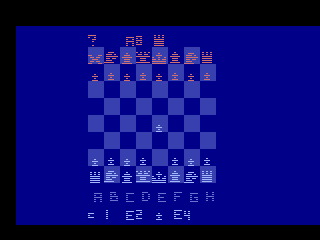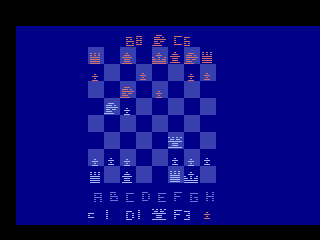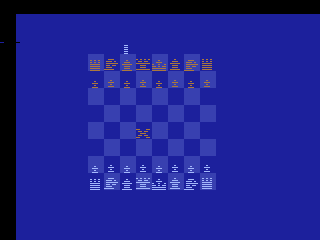|
|
Video Chess
|
Name:
|
Video Chess |
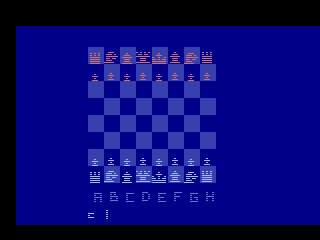 |
| Company: | Atari | |
|
Model #:
|
N/A | |
|
Programmers:
|
Bob Whitehead and Larry Wagner | |
| Year: | 1978 | |
|
Released?
|
No
|
|
|
Notes:
|
Originally called
Computer Chess |
Back in the early days of computing, having a Chess game
for your computer was considered a must. Not only did it
show that computers could be used for 'intelligent recreation',
but it also helped show off the raw power of your system.
This obsession also trickled down to game consoles even though
most of them were woefully underpowered for something as
demanding as Chess. Still, game companies managed to get a
Chess game on almost every system (sometimes cheating with extra
hardware), and the Atari 2600 was no exception. The funny
thing is though, Atari wasn't originally planning on bringing
Chess to the 2600 at all!
You see, Atari was in a bit of pickle at the time. They were currently being sued for lack of a Chess cartridge. Atari had never planned to do a chess program as everyone thought that Chess was well beyond the capabilities of the 2600. However someone forgot to tell marketing this and they stuck a big ol' Chess piece on the system box (original 1977 version only). Apparently some man in Florida had bought the 2600 assuming that it would have a Chess program available (after all they 'advertised' it right on the box!). After realizing that Atari planned no such thing, he sued for false advertising. So Atari could either cough up a Chess cartridge or pay out a lot of money in lawsuits. Thus Video Chess was born.
So now that you know the history behind Video
Chess, how does it play? Well, while the computer AI
won't win any awards for speed, it does play a competent game
of Chess. Video Chess has eight different variations
(skill levels) ranging from beginner to expert. The
easiest skill levels will allow even the most novice Chess
player a chance to beat computer, while the harder levels will
give expert players a run for their money. The only
problem is that due to the low amount of RAM available and the
slow processor of the 2600, the computer can take 10-20
minutes per move at the intermediate levels and several HOURS
at the highest levels. In order to free up as much RAM
and processor time for the computer to think, the screen is
blanked out when the computer is computing its move. To
let people know that the 2600 was merely thinking and not
dead, they made the screen flash different colors during this
time.
So now that you know the history behind Video Chess, how does it play? Well, while the computer AI won't win any awards for speed, it does play a competent game of Chess. Video Chess has eight different variations (skill levels) ranging from beginner to expert. The easiest skill levels will allow even the most novice Chess player a chance to beat computer, while the harder levels will give expert players a run for their money. The only problem is that due to the low amount of RAM available and the slow processor of the 2600, the computer can take 10-20 minutes per move at the intermediate levels and several HOURS at the highest levels. In order to free up as much RAM and processor time for the computer to think, the screen is blanked out when the computer is computing its move. To let people know that the 2600 was merely thinking and not dead, they made the screen flash different colors during this time.
Video Chess was the first 2600 game to break the 4K barrier, originally weighing in at a hefty 6K! Rather than go through the expense of releasing Computer Chess as a bankwitched cart, Atari decided to strip it down so it could fit into a regular 4K cart. Some of the things that were axed to free up space were the Chess notation that was originally displayed in the Computer Chess prototype and two of the highest skill levels. This was probably a good trade off to save costs. While the notation might have been missed by the more serious Chess players the average Joe probably didn't even notice, and the two missing variations were borderline unplayable given how long they took between moves.
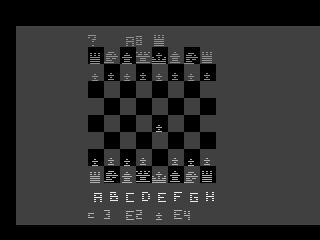
Did you ever notice how the chess pieces are made up of lines? This is because of a special trick created by Bob Whitehead to display more than six sprites per line (which wouldn't have been enough for Chess). This trick called "Venetian Blinds" allowed the 2600 to display up to eight sprites per row (instead of the normal six) by alternating them between two sets of scanlines (four on one set of scanlines, and four on the other). It was the development of this trick that made a Chess program on the 2600 possible.
While it may not be able to stand toe to toe with some of the more advanced Chess programs of the time, Video Chess is a pretty amazing feat of programming for the 2600. Video Chess was well received and prevented any kind of lawsuit from going forward. Video Chess was also instrumental in developing several new programming and hardware techniques for the 2600 (Venetian Blinds and Bankswitching) which helped Atari get the most out of the 2600. It's just a shame that a more advanced Chess program was never made to take advantage of the ever evolving 2600.
| Version | Cart Text | Description |
| 7/7/78 | Ches 7-7-78 | EPROM board only |
| ?/??/78 | Computer Chess | Prototype cart has a production end label. |
| ?/??/80 | 1-10 6K Chess 11-14 2K Othello |
6K Version |

